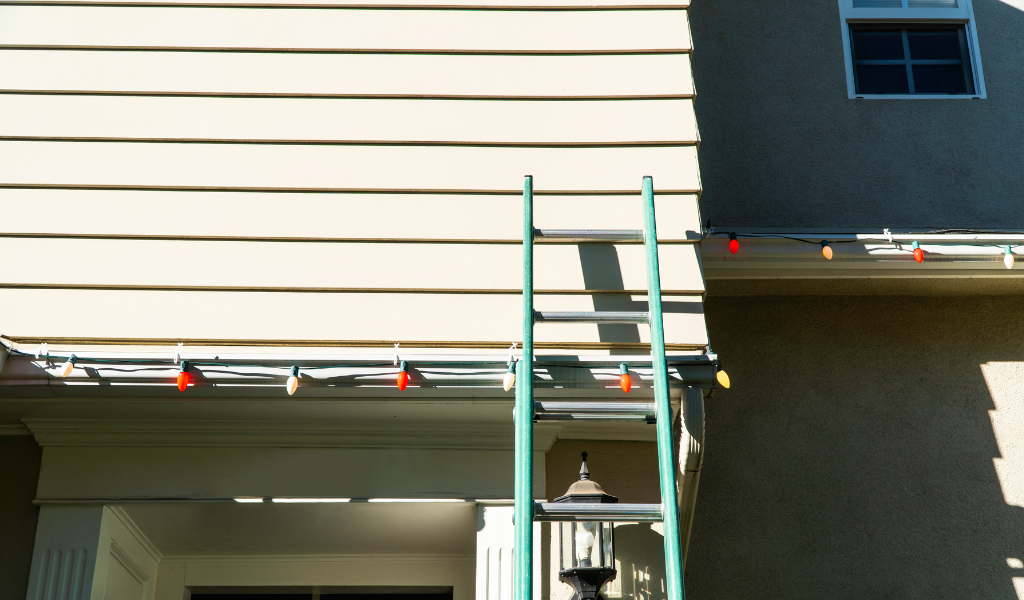It was a hot Wednesday afternoon in late August when Joe, a roofing contractor with 18 years on the job, got the call. The client sounded rattled. “The roof looks great,” she said, “but… did your ladder melt my siding?”
Joe drove back over, heart in his throat. Sure enough, two pressure dents and a few scratches had formed where the ladder feet leaned against the home’s beige vinyl siding. Nothing catastrophic, but enough to spark a complaint and—worse—a ding to Joe’s word-of-mouth referrals.
This kind of thing happens more than you’d think. Whether you’re hanging lights, cleaning gutters, or doing a full roof job, leaning a ladder against a home can leave behind more than just footprints. Vinyl siding is flexible, easily marked, and not built to withstand the sharp pressure of ladder rails or feet.
Let’s talk about how to prevent your ladder from damaging vinyl siding—because protecting the home is just as important as finishing the job.

Why Vinyl Siding Gets Damaged So Easily
Vinyl siding looks tough from a distance. But up close, especially in hot or cold weather, it’s a different story.
Softens in heat: Vinyl expands in the sun and gets more pliable. That makes it prone to dents and warp lines under weight or pressure.
Brittle in cold: Cold snaps make it rigid. One hard press from a ladder in freezing temps can crack or snap a panel.
Not load-bearing: It’s not designed to support the concentrated pressure of metal ladder rails, especially over time or with shifting weight.
If you’ve ever leaned a ladder against vinyl and seen the rails press in like a spoon into warm butter, you know the risk. And once it’s marked, there’s no buffing it out.
Common Mistakes That Lead to Siding Damage
How To Protect Gutters When Cleaning Leaves
1. Leaning Without Padding
Some folks wrap a towel or hoodie around the top of the ladder as a quick fix. Not only is that a slip hazard, it’s not even consistent padding. The pressure still cuts through.
2. Ignoring the Angle
A steep ladder angle increases vertical force, which digs those rails deeper into siding. The recommended 4:1 ratio (one foot out for every four feet of height) helps with balance, but it doesn’t eliminate pressure damage.
3. Skipping the Right Tools
It’s common to spend big on a ladder but skip investing in the right accessories to protect the home. If you’re a pro or even just value your home’s exterior, this part matters.
Joe the Roofer’s Fix: A Real-World Product That Works
Joe didn’t wait for another complaint. He talked to some folks online and came across Ladder’s Little Helper. It’s a heavy-duty, no-slip ladder standoff that grips the wall and spreads out the ladder’s force. Designed specifically to prevent ladder from damaging vinyl siding, it’s a tool made for pros who care about leaving no trace.
“Now I won’t show up to a job without it,” Joe says. “It’s as important as my harness or nail gun. If you’re gonna lean something against someone’s house, you better do it right.”
He’s not alone. Plenty of tradespeople have added similar products to their rigs—not just to avoid complaints, but to keep their work clean and professional.
Tips to Prevent Ladder Damage to Vinyl Siding
Whether you’re a seasoned tradesperson or a handy homeowner, these tips go a long way:
Use a Ladder Stabilizer or Standoff
Products like Werner’s or the Ladder’s Little Helper spread the contact points, reducing pressure on a single panel. Bonus: they also give you more room to work near windows, gutters, and eaves.
Avoid Direct Contact
Even a folded drop cloth isn’t enough. Your ladder should rest on something designed to protect surfaces, not just cushion impact. Look for stabilizers with non-marking rubber feet or soft plastic guards.
Work from the Roof Line When Possible
Set the ladder to extend past the roof edge and climb up to it, rather than leaning it midway up a wall. This reduces time and pressure on vertical siding areas.
Check the Weather
Avoid leaning ladders against vinyl in extreme temps. In hot weather, it dents. In cold, it cracks. If you must, use extra padding and keep weight shifting to a minimum.
Mind the Movement
Constant climbing and descending causes micro-shifts that grind the rails into siding. Use a stabilizer to help keep your ladder fixed in place and balanced.
A Word from Marianne, DIY Gutter Cleaner Extraordinaire
“I bought a basic ladder from the hardware store and didn’t think twice—until I noticed little dents in my own siding after cleaning out the gutters. Now I never go up without a stabilizer. It’s just one of those ‘why didn’t I do this sooner?’ things.”
Marianne runs her own home maintenance blog and swears by practical, tested advice. She’s one of many DIYers who’ve made the upgrade after seeing damage firsthand.
Check out blogs like Pretty Handy Girl or The Family Handyman for more real-world gear tips and ladder setup advice (again, we skip the safety stuff, but these sites cover it all).
Protecting Homes While You Work
You work hard to build your reputation—don’t let one dented panel undo it. At the end of the day, preventing ladder damage to vinyl siding is part of doing the job right. It’s a small step that shows big care.
If you’re regularly climbing ladders for work—or weekend projects—take the time to add a reliable, protective tool to your setup. Ladder’s Little Helper was built with this exact issue in mind.
Want more tips like this? Subscribe to our blog for monthly gear breakdowns, real-world use cases, and professional tricks that keep homes looking sharp while you work.
Got a trick of your own for preventing ladder damage to siding? Drop it in the comments—we love hearing from fellow pros and handy folks who get the job done right.


